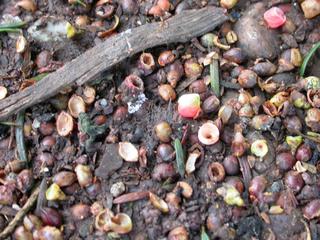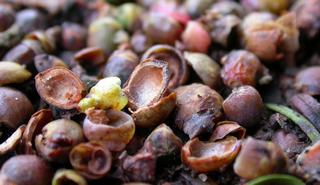

Worcestershire Record No. 20 April 2007 p. 25
Harry Green
The hawfinch has always been a jinxed bird for me. The first sighting I ever made was many years ago when mist netting to catch woodland birds for ringing near Malvern. I glanced up at a net set up in a clearing and as I did so a hawfinch hit the top panel of the net, bounced, and flew away! That was it until a few years ago when Brett Westwood took me to the woods well-known for wintering hawfinches near Ludlow. We saw the birds. Brett described the results as ‘good views’. The treetop dots I saw were certainly hawfinches but they promptly flew away! However the unprecedented large number of sightings in Worcestershire during the recent winter (2005-2006) raised my hopes so I followed the bird watching trail to Croome. I did indeed have good views of a hawfinch amongst a flock of finches (mainly greenfinches) feeding on fallen yew berries.
The Croome site is at the High Green end of the Croome Landscape Park. It lies near the grotto and lake and consists of a grove of yew trees, grassy area areas and a scattering of other trees and shrubs. The yew trees carried a very heavy crop of berries and at the time of my visit on 1st January 2006 the ground under the yews was densely carpeted with fallen berries. Many of the hard seeds had been split open and the kernels extracted through the feeding activities of both greenfinches and hawfinches. Up to 20 hawfinches at one time were recorded there but the numbers varied widely from day to day, hour to hour.
 |
 |
| Two pictures showing split yew seeds at Croome | |
Nationally the winter 2005-2006 has been remarkable for hawfinches. In October they were seen crossing the coast in various places, many of them, surprisingly, in the south and south-west, and there have been reports from all over Britain and Ireland. The factors responsible for this invasion are as yet unknown. Perhaps they had an unusually good breeding season producing larger numbers of birds than usual. Perhaps there has been a food shortage on mainland Europe. Hopefully more information will become available and if ringed birds are found in breeding areas they will give a clue to their origins. At times in the past the occurrence of winter flocks seems to have been more frequent and it is interesting to speculate and wonder if some of those winter’s birds will remain in Britain and bolster the breeding population which has been dwindling for many years
Facts about hawfinches
What follows is a shortened version of an article written for Worcestershire Wildlife News, Worcestershire Wildlife Trust Newsletter April 2006.
This mighty finch is, overall, about 20% bigger than a greenfinch. The appearance is very well seen in John Robinson’s remarkable photographs. The most striking features are the massive bill and large muscle-bound head. This is the only finch that can crack open cherry and olive stones to extract and eat the kernel. The stone is held between four hard projections, two in the upper mouth and two below. The massive muscles attached to the skull and lower jaw then contract, the stone breaks open and the kernel is extracted with the tongue. It has been calculated that hawfinches exert a load of 60-95lbs to break open a cherry stone. Hawfinches eat a wide variety of hard seeds and other favourites are hornbeam, haws and yew seeds. Otherwise they feed on buds and insects. The nestlings are reared on caterpillars collected mainly from the leaves of trees, especially oaks.
According to Mountford’s book (The Hawfinch, Collins, 1957) the scientific name Coccothraustes is derived from the Greek and means ‘kernel-breaker’ so named in 1555. The name hawfinch is thought to be derived from Anglo-Saxon haga which means an enclosure or hedge and may refer to hawfinches winter feeding on the berries of the hawthorn used to surround the enclosures.
In the early 19th century hawfinches were very rare breeding birds in Worcestershire although flocks sometimes appeared in winter. In some parts of the county they became quite common in the late 19th century but thereafter declined and have since been regarded as scarce breeding birds, occurring mainly in the west. The abundant cherry orchards of those days were probably an important source of food. However, breeding birds are quite secretive and difficult to find – shy, elusive and wary are terms often applied to hawfinches in books! In recent years very few breeding birds have been found but keen bird watchers can usually find a few each winter, particularly in woods at the south end of the Malvern Hills, and near Ludlow. Even then they can be difficult to observe as they often feed high in hornbeam trees and quickly fly away if disturbed. Breeding birds are difficult to find but a few pairs may be lurking in west Worcestershire woods.
Hawfinches breed in a wide zone across central Europe and into Asia, extending to about 60° north. The Russian and other northerly birds move south and west in winter and very rarely some of these birds probably reach Britain, possibly in response to particular weather conditions. In the past flocks have occasionally appeared on the east coast in early winter, presumably newly arrived migrants.
More hawfinches than usual were seen in Britain last winter (2005-2006) and some of these may have been continental visitors. There were reports from several places in Worcestershire with, for example, a small flock resident near Croome for several weeks, feeding on fallen yew berries alongside greenfinches. Although parts of yew berries are poisonous both these finches can extract the harmless kernel. A single bird was found in Grafton Wood Reserve by volunteer manager John Tilt and he later saw it (or another) feeding on field maple seeds in the top of a nearby hedge.
The photographs with John Robinson’s article show the massive bill, the short tail and the extraordinary hooked tips of the inner primary wing feathers. The latter are though to be used in courtship displays when perched birds spread their wings towards their partner.
| WBRC Home | Worcs Record Listing by Issue | Worcs Record Listing by Subject |